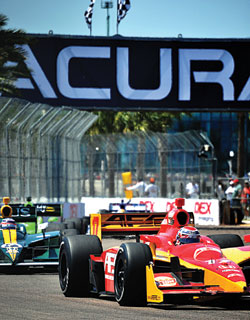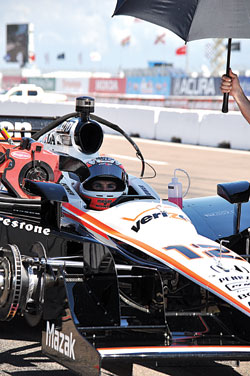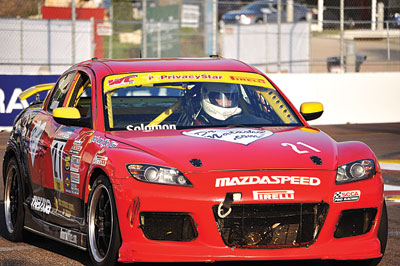
Rob Bibelhauser
Contributing Writer
Photos by Aimee Alexander/Crow’s Nest
Every year, the Honda Grand Prix of St. Petersburg offers USF St. Petersburg students a front-row seat to the Indy Racing League’s first event of the season.
The 2011 rendition of the race saw some immediate effects of new rules implemented by officials with the IndyCar Series. They were enacted to encourage a better show for the fans since some believe NASCAR is more exciting than the IndyCar circuit. The biggest change is to have side-by-side starts to the races. In previous years, drivers would line up single-file in the position they placed during poling. This year, they are right next to each other at the start.

When the Grand Prix kicked off, there was not enough room on the track, resulting in a major crash that netted drivers Helio Castroneves, Ryan Briscoe, Mike Conway, Oriol Servia and Marco Andretti. Andretti, the grandson of racing legend Mario Andretti, had to have his car removed from the track by a tow truck.
“That’s what happens when you try to imitate NASCAR. Our cars have too much power. It creates disasters. It’s good for the fans, it’s not so good for [the drivers],” 24-year-old Andretti said as his Honda-powered Dallara was taken away.

Dario Franchitti was this year’s champion after narrowly escaping the five-car pileup in the first turn of the first lap. Franchitti grabbed the lead from pole sitter and 2010 champ Will Power, leading for 94 out of the 100 laps on his way to the winner’s circle.
Even Franchitti recognized the issues with the new changes and said team owners were in favor of them.
“There are probably a few of them sitting there scratching their heads just looking at bills for carbon fiber,” he said, “and going, ‘Why didn’t I ever think of that?’ ”
Frustrated after having won the pole but failing to win back-to-back St. Petersburg races, Power was not sold on the new rules, either.
“I wouldn’t call it successful,” he said. “The problem is they have so many cars bunched in such a tight space. I think this is just going to continue every race … people getting knocked out every single restart.”

Other subplots of the race included the emergence of fourth-place finisher Simona De Silvestro. The 22-year-old Swiss driver teamed up with new engineer Brent Harvey just before the race.
“I think we made the right choice,” she said. “When he talks to me on the radio, he’s really calming me down, so I think we’ll make a good team.”
St. Petersburg native Nick Andries, now in his second season of the Mazda Series, competed in the Star Mazda Series event this year and placed 17th out of 18. Andries, a St. Petersburg College mechanical engineering major, drives for Clearwater-based Team Pelfrey and scored four top-10 finishes during his rookie campaign.
The Grand Prix consists of a street course with 14 turns and a crossing near Residence Hall One. Skyler Rivera, a sophomore at USFSP, attended race events on the first day.
“My dad and I were pretty big race fans, so we had to check it out,” he said, adding that the noise wasn’t “too bad.”
Loud noise from the race was audible throughout downtown St. Petersburg during most of the events. While eating lunch on Central Avenue or studying in the library on campus, the sounds of racecars permeated the area. For those who didn’t mind the noise, rooftops provided a cheap seat for amateur photographers and even tailgaters looking to catch a view.
Regardless of whether the race was better than last year, the Indy Racing League is in a transition period. The league’s efforts to increase fan excitement have so far resulted in frustrated drivers. However, it is still too soon to make any major assumptions about how the new rules will impact the sport.




